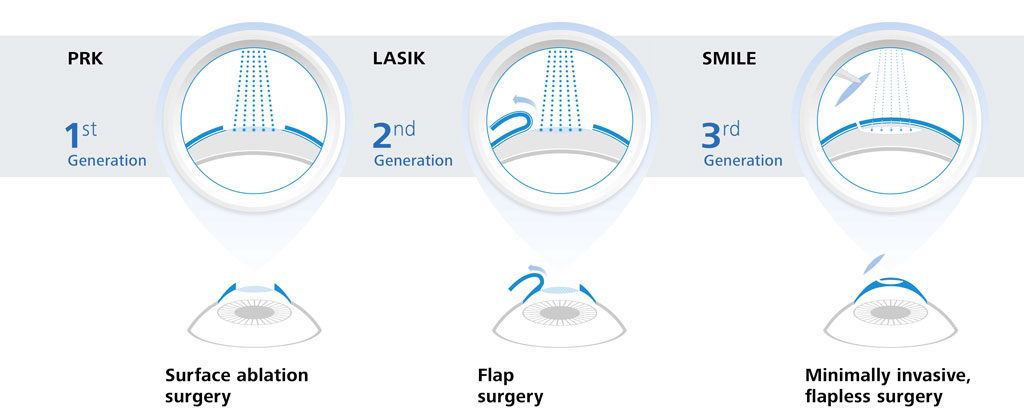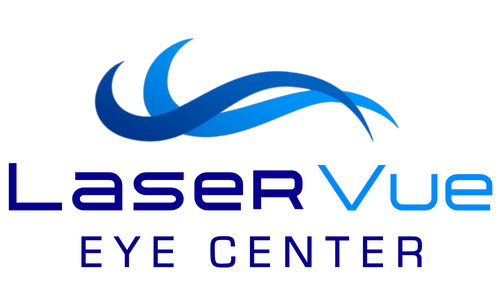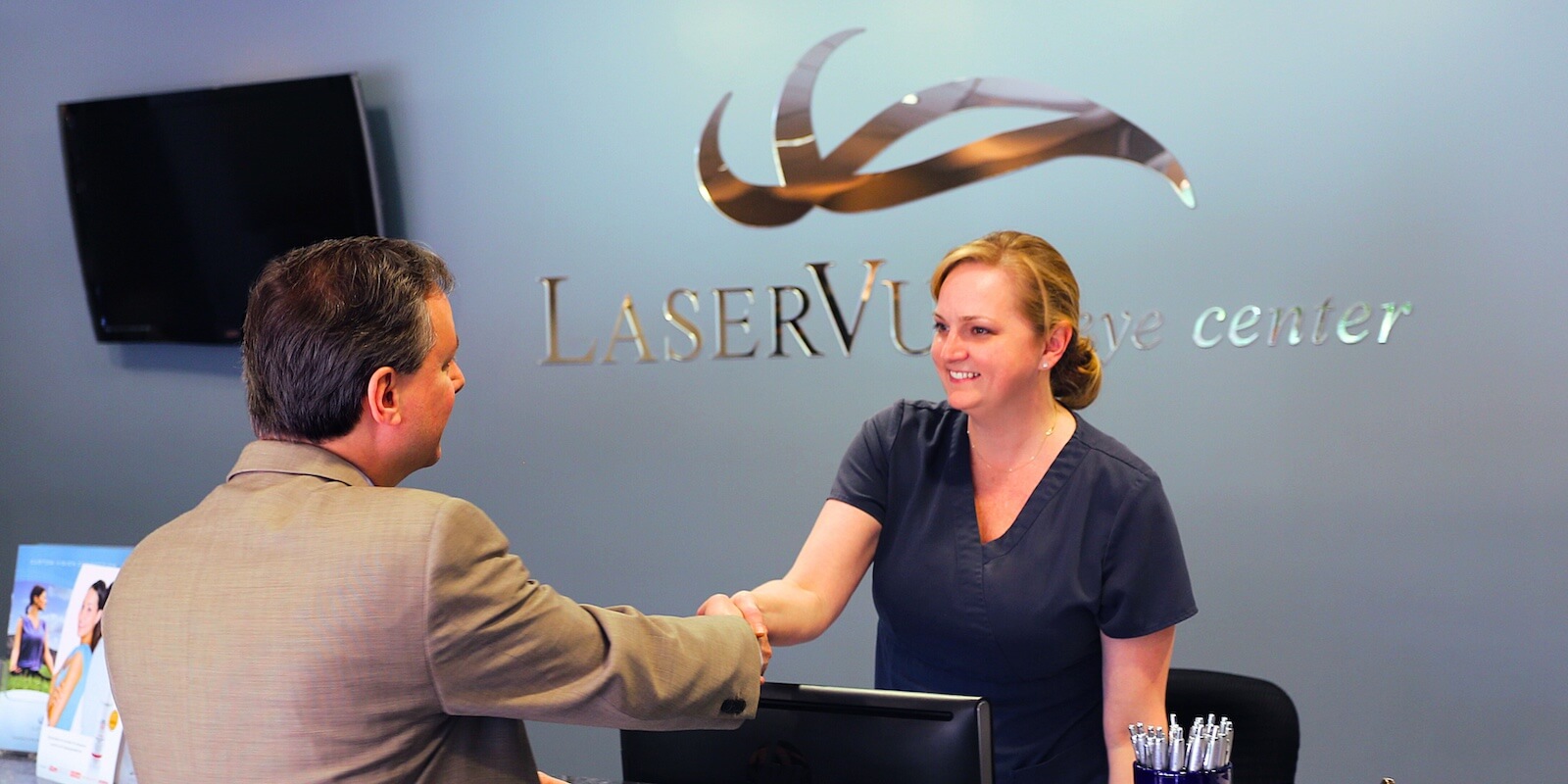Posted by: LaserVue LASIK & Cataract Center in LASIK,SMILE

Which is Right for Me: SMILE, LASIK or PRK?
If you’re ready to live your life free from glasses and contacts, then you’ve probably decided that laser eye surgery is the best option for you. However, knowing which procedure is the best for you can be a bit more difficult. Often times, those who have chosen laser eye surgery find themselves weighing three possible options for their procedure: SMILE, LASIK or PRK Surgery.
All three surgeries are trusted, safe, and effective ways to correct your refractive vision errors. However, eyes are like fingerprints; no two eyes are the same. Therefore, which procedure is ultimately best for yours? In this blog, we will walk through the unique benefits and considerations of each procedure, so you can make better informed decisions on your journey to clearer vision.
1st Generation: PRK
(Photorefractive Keratectomy)

Photorefractive Keratectomy, or PRK, is considered by many to be the first generation of laser vision correction. PRK originally received approval from the FDA in 1996 and continues to be used by surgeons today for the correction of myopia or nearsightedness, hyperopia or farsightedness, and astigmatism.
During the PRK procedure, the outer layer of your cornea, also known as the epithelium, is gently removed using a manual instrument. Your surgeon will then use a highly-accurate laser, the cool excimer laser, to reshape your cornea and correct your vision.
When is PRK a Good Option?
PRK is a good option for patients with thin or irregular corneas, patients who are predisposed to chronic dry eye, and patients whose jobs or lifestyles cause them to take a lot of direct contact to the eyes. For example, boxers and fighters. Additionally, thin corneas, dry eye, and high-risk occupations can cause a patient to not be a suitable candidate for LASIK (but still may be a great candidate for SMILE, which we’ll get to later).
Are there downsides to PRK Surgery?
The major consideration with PRK is longer recovery time. Understandably, PRK has the longest recovery period out of all three laser eye surgeries. This is because it takes about a week for the cells on the outer layer of your cornea to grow back. Afterwards, it can then take anywhere from two to six weeks for the cells to smooth and allow for clear vision.
If you were to elect to have PRK done in both eyes at once (which is an option), then you would typically need to take a week off of work or any kind of driving.
Additionally, for the same reasons, there is a higher chance of post-surgery discomfort when compared to SMILE or LASIK. As your epithelium grows back and with proper healing, post-surgery discomfort will decrease over time.
2nd Generation: LASIK
(Laser-Assisted Stromal In-situ Keratomileusis)

The majority of our new patients are familiar with LASIK eye surgery. This is because LASIK is the most commonly performed laser eye surgery in practice today.
Laser-Assisted Stromal In-situ Keratomileusis, or LASIK, was approved by the FDA in 1999 to treat mild to moderate nearsightedness, farsightedness, and astigmatism.
During the LASIK procedure, your eye surgeon uses a femtosecond laser to create a small flap of corneal tissue, which is then folded back. Then, your surgeon will use an excimer laser to reshape the underlying corneal tissue in order to correct your vision.
When is LASIK a Good Option?
In order to be a good candidate for LASIK, a patient needs to have an adequate corneal thickness. Since a flap is created during this procedure, a certain amount of corneal thickness is required. With this in mind, those with thin or irregular corneas may be unable to receive LASIK. Luckily, there are still options for patients with thin or irregular corneas, as these patients are typically better candidates for SMILE or PRK.
Additionally, If a patient is predisposed to chronic dry eye symptoms, then SMILE or PRK may be a better option. LASIK is known to run a higher risk for postoperative dry eye symptoms and can increase previously held chronic dry eye.
Are there downsides to LASIK Surgery?
LASIK is an extremely effective, safe, and trusted option. However, its one important consideration is it is a more complex procedure than its successor, SMILE, because it uses two lasers and creates a corneal flap during the procedure. Because of this, there is a potential for rare flap-related complications post-surgery.
Flap-related complications include microscopic wrinkles called striae, irregular astigmatism, epithelial ingrowth, inflammation, and dry eye syndrome. Flap-related complications are very rare, and your chance of encountering these complications are greatly decreased by partnering with an experienced LASIK surgeon.
For example, Dr. Jay Bansal at LaserVue Eye Center in the San Francisco Bay Area has helped over 25,000+ LASIK patients enjoy enhanced vision. Additionally, many LASIK patients have enjoyed the benefit of seeing 20/20 after surgery. When you visit LaserVue, you can rest assured that your eyes are in capable hands, and that we will provide you with the vision correction procedure that will lead to your ideal vision outcome.
3rd Generation: SMILE
(Small Incision Lenticule Extraction)

Small Incision Lenticule Extraction, or SMILE is the most advanced FDA approved laser vision correction procedure to date. SMILE has been in practice worldwide since 2012, and was approved for widespread use in the United States in 2016.
One-Step One-Laser Procedure
One of the main differences between SMILE and its predecessors is that SMILE is a one-laser procedure. Unlike PRK and LASIK, there is no use of an excimer laser during SMILE. Instead, your surgeon will use a femtosecond laser to cut a tiny incision in the cornea and use it to remove a small piece of corneal tissue called the lenticule. This reshapes the cornea and improves vision.
Less Invasive Surgery
Notably, SMILE is a less invasive laser eye surgery procedure than LASIK. During the LASIK procedure, your surgeon creates a flap that is 20mm in circumference. A PRK procedure creates an 8mm diameter surface removal. In comparison, SMILE creates only a 3mm corneal “key-hole” incision. This allows for more corneal stability post-surgery, and less disturbance to corneal nerves during surgery.
Quiet, Odorless, and Blade-Free
During both LASIK and PRK, an excimer laser is used to reshape the cornea. During these procedures, this laser makes a clicking sound and creates a noticeable odor. Since the excimer laser is not used during SMILE, the procedure is quiet and odorless.
No Flap-Related Complications
Because SMILE does not create a flap like LASIK, there is no risk of flap-related complications after surgery.
Safe, Accurate, and Fast Visual Recovery
Most importantly, clinical trials for SMILE have found it to be just as safe and accurate as LASIK.
Are there downsides to SMILE surgery?
The one consideration that is important regarding SMILE is that it is not yet available to treat farsightedness or astigmatism. SMILE is currently only available to treat certain types of nearsightedness, or myopia.
Additionally, visual recovery takes a slightly longer time after SMILE compared to LASIK. With a LASIK procedure, a patient can experience instant visual recovery. However, SMILE’s visual recovery can take about one to two days. Still, both procedures have the benefit of a fast recovery compared to procedures such as PRK.
SMILE Laser Eye Surgery at LaserVue Eye Center
SMILE is considered the most significant advance in laser eye surgery technology in over 10 years. This procedure offers even greater comfort and potentially greater precision than its predecessors.
Dr. Jay Bansal at LaserVue Eye Center is proud to be the first doctor in Northern California to offer the Zeiss VisuMax Laser for SMILE Laser Vision Correction. As a leader in SMILE and other laser eye surgeries, Dr. Bansal provides patient education and excellent service to his patients, from offering a free vision correction consultation to investing in the latest advancements in technology.
Which is Right for Me?
Ultimately, only a comprehensive eye exam and consultation by your surgeon can determine which procedure is the best for you. If you would like to learn if SMILE, LASIK or PRK is the best option for you, then call or schedule your complimentary consultation online today.

